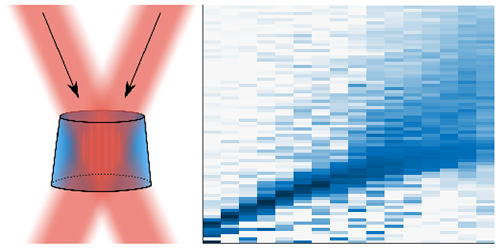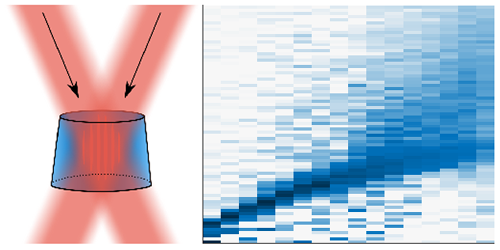How a Superfluid Becomes a Bose-Einstein Condensate
Ultracold gases of fermionic atoms offer researchers a way to study quantum many-body phenomena using measurement techniques from atomic and molecular physics. In a new experiment, Hauke Biss of the University of Hamburg, Germany, and colleagues have used such a gas to measure the excitation spectrum of a quantum many-body system that undergoes a transition from a Bose-Einstein condensate (BEC) to a Bardeen-Cooper-Schrieffer (BCS) superfluid [1]. The results provide important benchmark data for theories of strongly interacting Fermi gases in settings such as neutron stars and unconventional superconductors.
The team trapped a gas of fermionic lithium-6 atoms and, by tuning a magnetic field, varied how strongly the atoms interacted. Weakly interacting atoms produced a superfluid by forming relatively loosely bound Cooper pairs, analogous to the electron pairs in a conventional superconductor. Stronger interactions caused each atom to couple to many of its neighbors. Increasing the binding energy even further, the atoms paired up to form tightly bound, molecule-like bosons, condensing into a BEC.
To study this “BEC-BCS crossover,” the team used lasers to generate excitations in the gas at different atomic interaction strengths. The spectra of these excitations near the crossover can provide clues about the nature of superconductivity, but until now it has been largely unexplored.
The researchers found that the measured spectrum agreed with theory in the BEC and crossover regimes, exhibiting a feature called the superfluid gap—an energy range where no excitations can occur. Toward the BCS regime, however, measurements and theory diverged. Biss and colleagues say that the discrepancy could help researchers improve theories of strongly correlated superfluids by, for instance, including a consistent description of particle-hole excitations that form as a result of particle-energy fluctuations.
–Sophia Chen
Sophia Chen is a freelance science writer based in Columbus, Ohio.
References
- H. Biss et al., “Excitation spectrum and superfluid gap of an ultracold Fermi gas,” Phys. Rev. Lett. 128, 100401 (2022).





